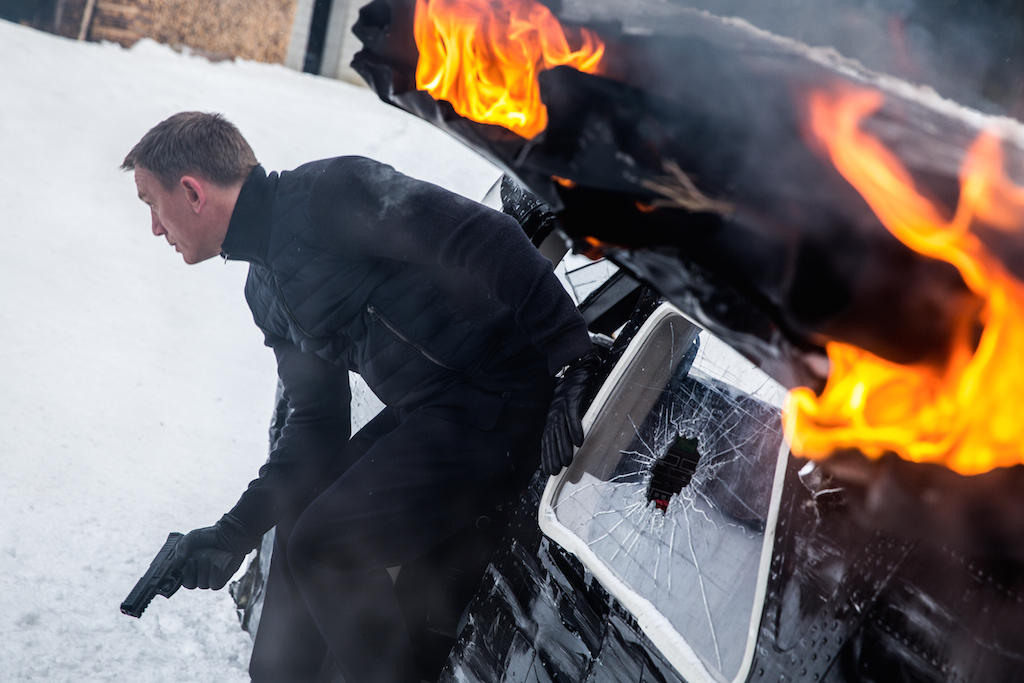
Daniel Craig recently said that he’d rather “kill himself” than do another Bond film—and in Spectre, his misery shows. He’s always been a different kind of Bond—more detached, more steely, more cool—but here he looks positively uninterested. Someone needs to remind Craig that there’s a difference between “unflappable” and “not able to muster any facial expressions.”
This is particularly ironic because, with Spectre, Craig has been gifted (trolled?) with the cheesiest opening credits sequence of any Bond film in recent memory. I’m talking Octopussy levels of cheesy. Suffice it to say, it involves Craig shirtless, bronzed, and draped in octopus tentacles and hot babes. Sam Smith’s disco-flavored theme song adds to the wonderful awfulness.
There’s some real cognitive dissonance between those retro-cheesy opening credits and the film itself—which is slick, expensive-looking, and largely bloodless. The tone is set right out of the gate. Opening Bond sequences are supposed to be jaw-dropping, so outrageously over-the-top that you laugh with giddy delight. Instead, we’re treated to a generic rooftop chase scene, an explosion, and a fight on a wayward helicopter, all of which seem pretty routine by Hollywood action standards. At least the backdrop to all of this—Mexico City’s Day of the Dead parade—creates some arresting images. Director Sam Mendes sure knows how to frame a pretty scene.
From there it’s all the same stuff we’re used to seeing, but done in a particularly joyless way. There’s a new M, played by Ralph Fiennes (wasted), and a new villain played by Christoph Waltz (predictable), and some plot involving the trendy topic of global surveillance. There’s much globetrotting—Austria, Rome, Tangier, and London are among the locales—all ticked off in a workmanlike way, with skyline shots to prove they were really filmed on location (the film showed us the London Eye so many times, I assumed it would eventually become part of the action—no such luck). As usual, Bond goes rogue and his allies at MI6 (including Ben Whishaw’s Q and Naome Harris’s Mrs. Moneypenny) scramble to cover for him. As usual, he crashes tricked-out cars, tracks down the Big Bad and his henchmen (Dave Bautista is convincingly scary as the henchman supreme), and beds two women—Monica Bellucci and Léa Seydoux—the latter of whom he falls for. The romance with Seydoux, however, is as listless and unconvincing as the rest of the film. (When she tells Bond she loves him, even he looks a little surprised.)
For a Bond film, there are surprisingly few gadgets—although there is a funny bit involving a car that Bond steals from Q’s lab that hasn’t been outfitted with all its bells and whistles yet—and when the sexy, audacious Bond theme interrupts the action, it actually feels out of place.
Here’s the deal. These days, Bond films are competing with the likes of Mission Impossible, the Bourne series, and even the Fast and Furious franchise for action supremacy. If they can’t top them, action wise, they better take advantage of their inherent Bondness. The cars, the women, the tuxes, the martinis, the wisecracks—these are the things we’re watching for. It’s all meant to be fun escapism, served with a wink, not dour and serious stuff. A Bond that takes itself too seriously is no Bond at all.
